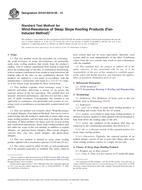Potrebujeme váš súhlas na využitie jednotlivých dát, aby sa vám okrem iného mohli ukazovať informácie týkajúce sa vašich záujmov. Súhlas udelíte kliknutím na tlačidlo „OK“.
ASTM D3161/D3161M-14
Standard Test Method for Wind-Resistance of Steep Slope Roofing Products (Fan-Induced Method)
Automaticky preložený názov:
Štandardná skúšobná metóda pre veternú rezistencie strmého svahu strešnej krytiny (Fan-indukovanej metóda)
NORMA vydaná dňa 1.7.2014
Informácie o norme:
Označenie normy: ASTM D3161/D3161M-14
Poznámka: NEPLATNÁ
Dátum vydania normy: 1.7.2014
Kód tovaru: NS-22676
Počet strán: 4
Približná hmotnosť: 12 g (0.03 libier)
Krajina: Americká technická norma
Kategória: Technické normy ASTM
Anotácia textu normy ASTM D3161/D3161M-14 :
Keywords:
asphalt shingles, clay tiles, concrete tiles, fan-induced winds, fiber-cement shingles, interlockings, metal shingles, photovoltaic shingles, polymer-based shingles, rigidities, roofings, sealants, steep slope roofing products, tabs, wind resistance, ICS Number Code 91.100.50 (Binders. Sealing materials)
Doplňujúce informácie
| Significance and Use | ||
|
5.1 Most steep slope roofing products that have demonstrated wind resistance by this test have also performed well in use. Natural wind conditions differ with respect to intensity, duration, and turbulence; these conditions are beyond the means of this test to simulate. The results of this test do not directly correlate to wind speeds experienced in service, and no accommodation is made in this test method for building height, building exposure category, or building importance factor. 5.2 Many factors influence the wind resistance of a steep slope roofing product in the field; for example, temperature, time, roof slope, contamination by dirt and debris, and fasteners, both appropriate and inappropriate, that are misaligned or misplaced, or over- or under-driven, and sealant adhesion, if used and functioning. It is beyond the scope of this test method to address all of these influences. This test method is designed to evaluate the wind resistance of products as described in the scope when representative samples are applied to test panels in accordance with the manufacturer’s instructions and conditioned as specified before testing. |
||
| 1. Scope | ||
|
1.1 This test method covers the procedure for evaluating the wind resistance of many discontinuous, air permeable, steep slope roofing products that results from the product's rigidity, with or without contribution from sealant to help hold down the leading edge of the tabs, or mechanical interlocking, with or without contribution from sealant to help hold down the leading edge of the tabs, or any combination thereof. The products are applied to a test panel in accordance with the manufacturer’s instructions and tested at a 2:12 (17 %) slope, or at the lowest slope permitted by those instructions. 1.2 This method evaluates wind resistance using a fan-induced procedure, delivering a stream of air across the exposed surface of the test specimens. This method does not measure structural performance, and does not provide a measure of uplift resistance. Consequently, this method is not applicable to continuous, non-permeable roof systems or coverings (such as membranes or mechanically-seamed metal roof panels). 1.3 This test method was formerly titled “Wind Resistance of Asphalt Shingles (Fan-Induced Method)” but was revised to acknowledge that the method is applicable to many other steep slope roofing products and has been used to evaluate the wind resistance of those products for many years by several testing and certification laboratories. Steep slope roofing products that fall under the scope of this test method, in addition to asphalt shingles, are polymer-based shingles, fiber-cement shingles, concrete tiles, clay tiles, metal shingles, and photovoltaic shingles. 1.4 This test method is limited to steep slope roofing product applied with a maximum exposure of 410 mm [16 in.]. 1.5 The values stated in either SI units or inch-pound units are to be regarded separately as standard. The values stated in each system may not be exact equivalents; therefore, each system shall be used independently of the other. Combining values from the two systems may result in non-conformance with the standard. 1.6 This standard does not purport to address all of the safety concerns, if any, associated with its use. It is the responsibility of the user of this standard to establish appropriate safety and health practices and determine the applicability of regulatory limitations prior to use. |
||
| 2. Referenced Documents | ||
|
Odporúčame:
Aktualizácia technických noriem
Chcete mať istotu, že používate len platné technické normy?
Ponúkame Vám riešenie, ktoré Vám zaistí mesačný prehľad o aktuálnosti noriem, ktoré používate.
Chcete vedieť viac informácií ? Pozrite sa na túto stránku.




 Cookies
Cookies
